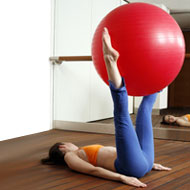- Aromatherapy (36)
- Benefits of Yoga (282)
- Home Remedies (1087)
- massage therapy (9)
- Preventive Therapy (135)
- Running (41)
- Skin Care (15)
- Stress Relief (25)
- Stretching (5)
- walking (33)
- Womens Health (14)
- Yoga Benefits for Pregnant Women (16)
- Yoga Benefits for Students (3)
- Yoga for Children (11)
- Yoga for Holistic Living (37)
- Yoga for Midlife Crisis (3)
- Yoga for Senior Citizens (2)
- Yoga for the Workplace (1)
- Yoga Health Tips (185)
- Yoga Practice during Menstruation (5)
Exercising with a Right Sized Yoga Exercise Ball

Exercise balls have been used for centuries. Apparently, they were also used by Hippocrates who is considered the father of modern medicine. According to researchers, he stitched animal skins together and stuffed them with sand, in the shape of a ball. People with back injuries were advised to use them.
Exercise balls are now used extensively in gyms and even for yoga. They are incorporated into exercises, which tend to increase strength, flexibility and balance. You can also combine yoga exercises with an exercise ball and integrate it into your fitness program. Care however, must be taken to select the right-sized exercise ball for optimum benefit.
Exercise balls are of many different kinds and come in a variety of colors, weight and sizes. They are usually made of rubber and are inflatable. These come with an inflating pump. Some kinds are made of leather and are stuffed with sand or some sort of heavy material.Try however, to buy the best quality available to ensure long term durability.
Exercises Ball Size
Selecting an exercise ball of the right size: Your height and weight will determine the size and strength of the ball that you select. These balls come in different diameter sizes ranging from 45 centimeters to 80 centimeters, with 50, 55 and 60 centimeters in between.
Here is a chart which you can follow:
- Less than 5 feet tall – Ball diameter 45 cm
- 5 to 5 feet 5 inches – Ball diameter 55 cm
- 5 feet 6 inches to 6 feet – Ball diameter 65 cm
- 6 feet 1 inch to 6 feet 8 inches – Ball diameter 75 cm
- Above 6 feet 9 inches – Ball diameter 85 cm.
A basic thumb-rule to selecting the right size is to sit on an inflated ball, as if you are sitting on a chair. If your legs are at exact right angles, with the heels directly below the knees, then that ball is the right size for you.
Yoga Exercises With Exercise Ball
Yoga exercises with the ball: There are many yoga exercises which you can do with the ball.
- Downward Facing and Upward Facing Dog Pose
- Down Dog and Leg Lift along with Lunge Stretch
- Squats with the Ball
- Spinal Rotation
- Seated Stork Pose
- Warrior Iand Warrior II Pose
- Side Angle Pose
- Torso Rotation
- Scissor Kicks
- Quadruped on the Ball
- Child's Pose
- Forearm Balance
You can also do the Back Extension, Ball Balance, Hip Extension, Abs Roll, Ball Rotation and Ball Twist.
The exercises may seem easy, but are actually quite difficult to perform and need plenty of balance and care. Also, do not start them on your own. Take care to do them only after recommendation by an expert. In case of any problem, stop immediately and refer to a doctor or yoga expert.
- RSS Feeds -
- All posts
- All comments
- Balance Yoga Ball A balance Yoga ball made of elastic rubber. By and large these balls have a ...
- Exercises For Gym Ball You would have seen them lying around the gym and would have often wondered w...
- Reduce Weight with Pilates Ball Exercise Pilates ball exercise is good and it shows good results for weight reduction....
- Pilates- Balance Ball Workout Practicing yoga or Pilates is very healthy for your body. Practicing differen...